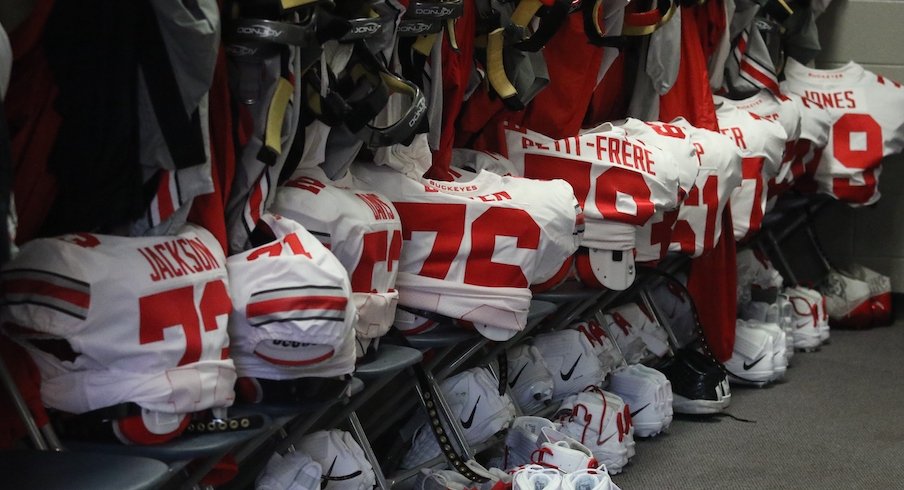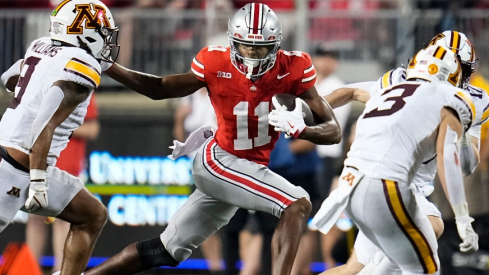As Friday rolled along, the ultimate conclusion became apparent.
Ohio State felt it could no longer guarantee everybody’s health for the football team’s upcoming game at Illinois the next day, so those in power in the athletic department moved to cancel it. The decision was made on Friday evening, and the football program was put on pause indefinitely.
“We made a decision last night to pause because our positivity rate reached a concerning level,” athletic director Gene Smith said. “We did not reach the Big Ten protocol thresholds, but the positivity rate was concerning enough where we felt we needed to pause and try and find a way to mitigate its spread and continue to ensure the safety of our student-athletes.”
Technically, going by the agreed-upon Big Ten protocols set up prior to the season, Ohio State did not have to shut down the Woody Hayes Athletic Center or cancel the game.
To have that happen, a football program has to surpass two thresholds that put it in the “red/red” category: A 7.5 percent population positivity rate (which measures the positivity rate of the 170 Tier I individuals, including coaches, players and staffers) and a 5 percent test positivity rate (which measures the rate of positive tests compared to the amount of tests administered).
Ohio State crossed the 7.5-percent threshold on Friday, but has not crossed the 5-percent threshold. Nevertheless, once more than 7.5 percent of Tier I individuals – or, in other words, 13 people – within the program tested positive, which happened on Friday, a decision was made to cancel Saturday’s game against Illinois and make moves to ensure the following weekend’s road tilt with Michigan State remains a possibility.
“Could we have played? Sure. Was it the right thing to play? No,” Smith said. “The standards that the thresholds define are guideposts.”
Team physician Jim Borchers added: “We were not in a position where, as you know from the medical subcommittee, where we would have been forced to stop and pause for seven days as we made those decisions and put those thresholds and guardrails in place. During that time, it was obviously there for that reason but also to give institutions the opportunity to assess the situation and make decisions that are best for their situations, and that's what we did yesterday is we had to make that decision when that population positivity threshold was crossed.”
As late as Friday afternoon, Ohio State still believed it would be able to play the football game versus the Illini on Saturday.
Travel plans were adjusted late in the week. Instead of leaving for Champaign, Illinois, on Friday evening as originally planned, it altered course to leave for its noon game early Saturday morning with a chartered flight set to take off around 8 a.m. from the John Glenn Columbus International Airport.
Additional testing beyond the Big Ten’s mandates was implemented to ensure safety. All Tier I individuals had PCR tests administered on Friday in addition to the daily rapid tests they undergo six days per week.
Even on Friday before those test results were returned, Smith said, Ohio State “felt that we could play.”
“But as we continued to test into the evening, the numbers got to the point where it became clear that we couldn't promise, first and foremost, that we would be putting our players on a plane and would be healthy and ultimately have a clean field on Saturday,” Smith said.
The first positive COVID-19 cases within Ohio State’s football team that led to the program shutdown two days later first popped up on Wednesday.
On one hand, team physician Jim Borchers said on Saturday, the undisclosed number of positive test results that popped up on Wednesday were “certainly” not enough to put all activities on hold and shutter the Woody Hayes Athletic Center. But at the same time, after a few months with what Borchers described as “essentially no cases of COVID-19” within the program, it caught Ohio State’s attention.
The Buckeyes shifted to virtual meetings on Wednesday. That day’s practice, along with practices the following two days, were altered to lessen exposure risk. There was no contact in practices, trash cans were used for walk-throughs, helmets weren’t used and masks were worn by everybody, head coach Ryan Day said.
“It was a practice on paper, but we weren't running and sweating and those things because we had to keep our masks on the entire time – or gaiters,” Day said. “We didn't go body against body.”
Not until Friday evening did Ohio State ultimately pull the plug on Saturday’s game and move to cancel it, so walkthroughs were held on Wednesday, Thursday and Friday, along with a Thanksgiving dinner at the practice facility on Thursday.
Borchers said Ohio State has not identified any specific pattern among those who have tested positive, and he mentioned there hasn’t been a single position group with a “cluster” of positive cases. Rather, as Smith put it, it has been “kind of a community type of spread” without spikes in specific areas.
“It really wasn't until yesterday when we did testing yesterday and enhanced testing yesterday that we really got to a point where it became very clear that we needed to pause,” Borchers said. “So unfortunately, this wasn't a decision we could make early in the week. This was really not a decision, from my standpoint, that could be made until yesterday.”


